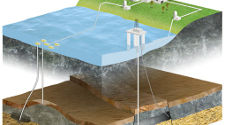
In August Richard Metcalfe gave a presentation about Quintessa’s flexible framework for integrated Performance Assessment (PA) of geological CO2 storage at a session of the 33ʳᵈ International Geological Congress in Oslo.
The session’s theme was risk and vulnerability assessment related to the geological storage of CO2.
An underlying principle of any PA framework is that it should be adaptable to meet the different needs of diverse stakeholders, including organisations that are implementing CO2 storage, regulators, and national and local governments. The framework should also be able to accommodate varied quantitative and qualitative information, represent uncertainties and handle multiple lines of reasoning.
Quintessa’s methodology uses three existing computer codes: the decision support code TESLA; an online database of Features, Events and Processes (FEPs); and the general purpose code QPAC. Decision trees are constructed in TESLA to reflect: (1) the PA’s context; (2) the specific FEPs that may influence the evaluated storage system; and (3) the kinds of information used to judge the characteristics and effects of interactions among FEPs. The decision trees are linked directly to the online database of FEPs, which can be used both as an audit tool and as an underlying knowledge base. Inputs to the decision tree are usually expert judgements, which can be made in varied ways, as required to meet the PA’s aims. Judgements can be based on evidence from a range of sources, including field and experimental observations, historical experience, and results from models of fundamental processes. These models cover the entire storage system (“system-level”) and specific system components (“detailed level”). The code QPAC can be used flexibly to help inform the inputs to a TESLA decision tree, by simulating the relevant coupled physical processes at both levels.